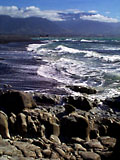
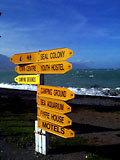 Although today was originally planned as the day that I was
going to accompany Bernard on a whale listening expedition,
the winds had picked up over the night and whipped the waters
off Kaikoura into something a little too rough for the small
boat that we were going to use. Hopefully we will be able to
get out tomorrow if the winds, which were blowing over 35 knots
by late afternoon, calm down. With the Kaharoa still tied
up to the dock in Wellington but scheduled to make the trip
down here later this evening, we had a couple of hours free
to explore Kaikoura before our meeting this afternoon with the
folks from Whale Watch tm Kaikoura.
Although today was originally planned as the day that I was
going to accompany Bernard on a whale listening expedition,
the winds had picked up over the night and whipped the waters
off Kaikoura into something a little too rough for the small
boat that we were going to use. Hopefully we will be able to
get out tomorrow if the winds, which were blowing over 35 knots
by late afternoon, calm down. With the Kaharoa still tied
up to the dock in Wellington but scheduled to make the trip
down here later this evening, we had a couple of hours free
to explore Kaikoura before our meeting this afternoon with the
folks from Whale Watch tm Kaikoura.
Kaikoura's main street
is similar to those found in most small beach communities around
the world. For the few blocks from the railroad bridge to
the Garden of Memories with
its whale jawbone-bordered paths, both sides of the street are lined with small shops, hotels and motels to suit any taste and budget, restaurants (many
of which we got to sample) and gift stores. However, Kaikoura also has some rather unique
facilities that highlight the wonderful ocean environment just
offshore including the Whale Watch tours run out of the old
railroad depot, the Dolphin Encounter, Swim with the Seals
and Dolphins and the Shark Cage Diving Adventure.
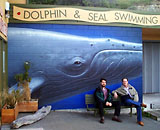
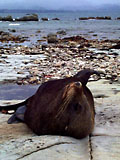 The folks in Kaikoura are obviously very proud of the marine
life in their
waters as demonstrated by the large number of buildings in town
having pictures of whales,
seals, dolphins and even crayfish (for which the town was named) painted, carved and hung upon. At the end of the peninsula is an outcropping of rocks across which are draped
large numbers of fur seals
seemingly oblivious to the presence of strangers. At one point while I was trying to get a picture
of one of the fur seals, it slowly rolled over, lifted its head up
into the air and let out what to me sounded like a mighty
yawn. Not being overly confident
in my fur seal communication skills, I decided that perhaps
I was being told that I had come close enough and that this
rock wasn't big enough for the two of us. Besides, there were
plenty more fur seals that didn't seem to be as concerned about a two-legged visitor.
The folks in Kaikoura are obviously very proud of the marine
life in their
waters as demonstrated by the large number of buildings in town
having pictures of whales,
seals, dolphins and even crayfish (for which the town was named) painted, carved and hung upon. At the end of the peninsula is an outcropping of rocks across which are draped
large numbers of fur seals
seemingly oblivious to the presence of strangers. At one point while I was trying to get a picture
of one of the fur seals, it slowly rolled over, lifted its head up
into the air and let out what to me sounded like a mighty
yawn. Not being overly confident
in my fur seal communication skills, I decided that perhaps
I was being told that I had come close enough and that this
rock wasn't big enough for the two of us. Besides, there were
plenty more fur seals that didn't seem to be as concerned about a two-legged visitor.
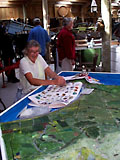 Kaikoura has a rich history, much of which is preserved and
on display at the Kaikoura District Museum and Archives, a
wonderful little museum maintained by a dedicated staff
of volunteers.
According to the folks at the museum, the Kaikoura District has
evidence of human occupation dating back more than 950 years when the
moa (large, flightless birds) hunter Maori settled in the
area. When Captain Cook sailed past in 1770 he found the locals
very cautious of his ship and the strange looking people on board.
Staying far away from his ship in their canoes, Cook decided to
name the peninsula Lookers On.
Kaikoura has a rich history, much of which is preserved and
on display at the Kaikoura District Museum and Archives, a
wonderful little museum maintained by a dedicated staff
of volunteers.
According to the folks at the museum, the Kaikoura District has
evidence of human occupation dating back more than 950 years when the
moa (large, flightless birds) hunter Maori settled in the
area. When Captain Cook sailed past in 1770 he found the locals
very cautious of his ship and the strange looking people on board.
Staying far away from his ship in their canoes, Cook decided to
name the peninsula Lookers On.
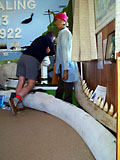 The whaling industry, established by Robert Fyffe (his house is
still standing) in 1843, attracted a varied group of people
from around the world. The life and history of these people
along with the traditions and culture of the original inhabitants
are presented in pictures and
artifacts that fill just about every inch of the museum's
several buildings. Not only are the traces of human habitation
displayed, but the museum also contains a large slab of rock
that contains the fossilized remains of a giant Plesiosaur that roamed the waters off Kaikoura
about 70 million years ago. Accompanying the fossil was the
story of how it was discovered and even more fascinating, how
it was airlifted off the beach and to the museum by an enormous
Russian-made supply helicopter.
The whaling industry, established by Robert Fyffe (his house is
still standing) in 1843, attracted a varied group of people
from around the world. The life and history of these people
along with the traditions and culture of the original inhabitants
are presented in pictures and
artifacts that fill just about every inch of the museum's
several buildings. Not only are the traces of human habitation
displayed, but the museum also contains a large slab of rock
that contains the fossilized remains of a giant Plesiosaur that roamed the waters off Kaikoura
about 70 million years ago. Accompanying the fossil was the
story of how it was discovered and even more fascinating, how
it was airlifted off the beach and to the museum by an enormous
Russian-made supply helicopter.
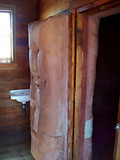 I would imagine that most of you have heard the expression
"padded cell" at some point, but how many people have
actually been inside of one. Well, thanks to the Kaikoura
Museum I can now say that I am not only one of the few people who
have had that opportunity, but was also able to get out of
there and write about it. It seems that the original
jailhouse in Kaikoura had one of its cells padded with thick,
relatively soft material (at least it might have been nearly
100 years ago) on the walls, doors and even floor. Unlike
many museums that I am more accustomed to, in this one you
were actually allowed to walk inside the original cell and
try and imagine what it must have felt like to be locked
inside. I for one can say that as crazy as the world might
seem some times, I would still much rather be on the outside
than on the inside of that one.
I would imagine that most of you have heard the expression
"padded cell" at some point, but how many people have
actually been inside of one. Well, thanks to the Kaikoura
Museum I can now say that I am not only one of the few people who
have had that opportunity, but was also able to get out of
there and write about it. It seems that the original
jailhouse in Kaikoura had one of its cells padded with thick,
relatively soft material (at least it might have been nearly
100 years ago) on the walls, doors and even floor. Unlike
many museums that I am more accustomed to, in this one you
were actually allowed to walk inside the original cell and
try and imagine what it must have felt like to be locked
inside. I for one can say that as crazy as the world might
seem some times, I would still much rather be on the outside
than on the inside of that one.
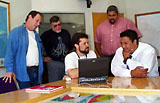
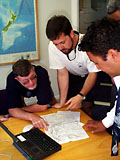 Later this afternoon, Clyde, Mike Sweeney, Bernard Brennan and I
drove over to the Whale Watch tm Kaikoura headquarters to meet
with some of their people and to discuss our plans as far as Clyde's
expected diving operations in Kaikoura Canyon and Bernard's
hydrophone monitoring of the diving behavior of the sperm whales.
Thomas Kahu, the Sea Operations Manager and Marcus Solomon, the
Operations Manager for Whale Watch tm Kaikoura took us into their
conference room overlooking the sea and almost in unison,
both Bernard and I placed our laptops on their conference
table and started them up. Clyde gave a brief overview of
the goals and general plans for the day to day operations
of the expedition and I showed them some of the
most recent SeaWiFS
satellite observations over Kaikoura and what we could learn
from them. Then it was Bernard's turn and he talked about the
work that
he has been doing over the past few weeks and presented some
of the dive profiles that he
had just processed. Plotting the results of his observations
in a more traditional fashion, Bernard showed us where the
greatest number of sperm whale dives have taken place.
Later this afternoon, Clyde, Mike Sweeney, Bernard Brennan and I
drove over to the Whale Watch tm Kaikoura headquarters to meet
with some of their people and to discuss our plans as far as Clyde's
expected diving operations in Kaikoura Canyon and Bernard's
hydrophone monitoring of the diving behavior of the sperm whales.
Thomas Kahu, the Sea Operations Manager and Marcus Solomon, the
Operations Manager for Whale Watch tm Kaikoura took us into their
conference room overlooking the sea and almost in unison,
both Bernard and I placed our laptops on their conference
table and started them up. Clyde gave a brief overview of
the goals and general plans for the day to day operations
of the expedition and I showed them some of the
most recent SeaWiFS
satellite observations over Kaikoura and what we could learn
from them. Then it was Bernard's turn and he talked about the
work that
he has been doing over the past few weeks and presented some
of the dive profiles that he
had just processed. Plotting the results of his observations
in a more traditional fashion, Bernard showed us where the
greatest number of sperm whale dives have taken place.
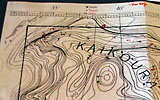 The largest number of little red dots, each one marking the
location of a generally 45 minute long feeding dive, was
found along one of the steep Kaikoura Canyon walls. If the
sperm whales are indeed hunting for giant squid as
everyone feels confident is the case, then this is the
most likely place to look for them with the Deep Rover.
Hopefully, the Kaharoa will arrive tomorrow and then everything
will be in place to begin the Search for the Giant Squid.
The largest number of little red dots, each one marking the
location of a generally 45 minute long feeding dive, was
found along one of the steep Kaikoura Canyon walls. If the
sperm whales are indeed hunting for giant squid as
everyone feels confident is the case, then this is the
most likely place to look for them with the Deep Rover.
Hopefully, the Kaharoa will arrive tomorrow and then everything
will be in place to begin the Search for the Giant Squid.
Bernard and I are hoping that the wind will finally calm down
enough for us to go out tomorrow morning and reconfirm these
findings. Also, since tomorrow will be my last day in Kaikoura,
I am hoping to be able to get out on the water at least once
before I leave.

 The folks in Kaikoura are obviously very proud of the marine
life in their
waters as demonstrated by the large number of buildings in town
having pictures of whales,
seals, dolphins and even crayfish (for which the town was named) painted, carved and hung upon. At the end of the peninsula is an outcropping of rocks across which are draped
large numbers of fur seals
seemingly oblivious to the presence of strangers. At one point while I was trying to get a picture
of one of the fur seals, it slowly rolled over, lifted its head up
into the air and let out what to me sounded like a mighty
yawn. Not being overly confident
in my fur seal communication skills, I decided that perhaps
I was being told that I had come close enough and that this
rock wasn't big enough for the two of us. Besides, there were
plenty more fur seals that didn't seem to be as concerned about a two-legged visitor.
The folks in Kaikoura are obviously very proud of the marine
life in their
waters as demonstrated by the large number of buildings in town
having pictures of whales,
seals, dolphins and even crayfish (for which the town was named) painted, carved and hung upon. At the end of the peninsula is an outcropping of rocks across which are draped
large numbers of fur seals
seemingly oblivious to the presence of strangers. At one point while I was trying to get a picture
of one of the fur seals, it slowly rolled over, lifted its head up
into the air and let out what to me sounded like a mighty
yawn. Not being overly confident
in my fur seal communication skills, I decided that perhaps
I was being told that I had come close enough and that this
rock wasn't big enough for the two of us. Besides, there were
plenty more fur seals that didn't seem to be as concerned about a two-legged visitor.

 Although today was originally planned as the day that I was
going to accompany Bernard on a whale listening expedition,
the winds had picked up over the night and whipped the waters
off Kaikoura into something a little too rough for the small
boat that we were going to use. Hopefully we will be able to
get out tomorrow if the winds, which were blowing over 35 knots
by late afternoon, calm down. With the Kaharoa still tied
up to the dock in Wellington but scheduled to make the trip
down here later this evening, we had a couple of hours free
to explore Kaikoura before our meeting this afternoon with the
folks from Whale Watch tm Kaikoura.
Although today was originally planned as the day that I was
going to accompany Bernard on a whale listening expedition,
the winds had picked up over the night and whipped the waters
off Kaikoura into something a little too rough for the small
boat that we were going to use. Hopefully we will be able to
get out tomorrow if the winds, which were blowing over 35 knots
by late afternoon, calm down. With the Kaharoa still tied
up to the dock in Wellington but scheduled to make the trip
down here later this evening, we had a couple of hours free
to explore Kaikoura before our meeting this afternoon with the
folks from Whale Watch tm Kaikoura.






